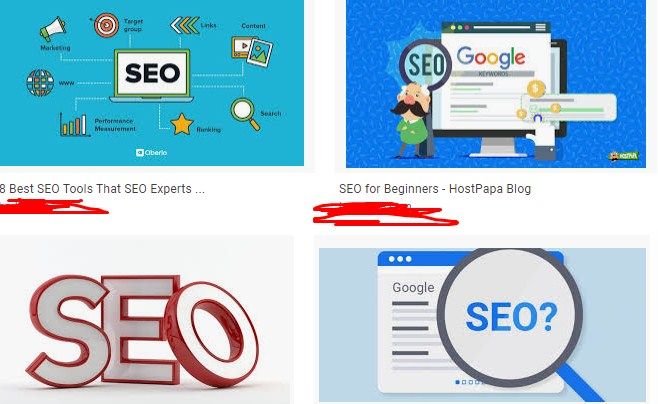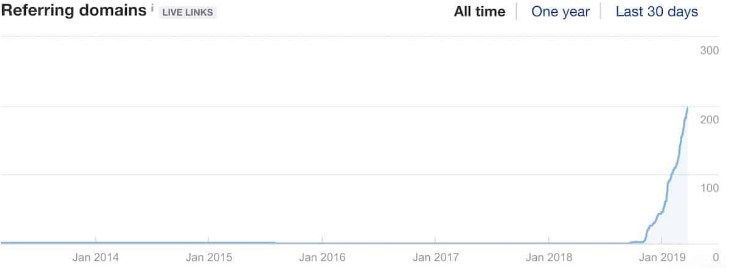All bloggers want to go from 0 to 100k visitors as quickly as possible. SEO for bloggers is the number one most important factor to help get you there.
Outstanding content isn’t enough anymore and Google is getting smarter. To rank your blog content now, it has to be long-form, properly structured for SEO, match user intent, and have other relevant, high Domain Authority (DA) sites pointing to it.

When I first started my blog, I had only 5 “pillar posts” – high-quality, long-form articles that I could easily get links to (bonus points if they have statistics to cite for easier links). After launch, I focused 100% of my energy on obtaining links to these articles rather than writing any new content.
Who’s gonna find me if I don’t have Domain Authority?
Luckily, I was able to find some hacks to scale my link building acquisition and guest blogging strategy.
According to Ahrefs, I obtained over 1,000 links from 200+ referring domains in my blogs first 90 days:

Here are some top SEO tips for bloggers to try this year.
Software of Contents
1. Research keywords and focus on 1-2 long-tail keywords that match your reader’s wishes
Optimizing your blog posts is not about stuffing as many relevant keywords into the article as you can (that can actually hurt your SEO now). It’s about writing for humans first, and search engines second.
Including 1-2 long-tail keywords that you’d like to rank for helps create solid content that doesn’t feel unnatural or forced. You should also focus on these long-tail keywords because they are longer, offer more user intent, and are usually less competitive.
Make sure to check different SEO tools to view the keyword “difficulty” score to see how much competition is out there for that keyword. If you have a new blog and are just starting out, aim for long-tail keywords in the 200-2,000 searches per month range with difficulty score under 0.2.
2. Include these 1-2 target keywords in specific areas of your post
Now that you’ve completed your keyword research and chosen 1-2 good keywords you’d like your blog post to rank for, it’s time to place them in your article.
Where are the best places to add these keywords so that your SEO rankings are as high as possible? There are four main places, outlined below:
1. Title Tag
The title (headline) of your blog posts will appear on the search engine results page (SERP) and will be the first thing search engine’s use to determine the relevancy of your content.
You’ll want to include your target keywords in the first 60 characters of the title, and make sure they’re at the beginning so they don’t get cut off (optimal title length is 50-60 characters. Bluehost is the best hosting
2. Your URL
Search engines still look to your URL to figure out what your blog post is about. It is a good idea to optimize your URLs on every post you publish, as each blog post will live on its own unique URL.
3. Headers and Body Copy
Mention your target keywords throughout your blog post’s headers and body content. You should stick with a natural cadence and not overdo it.
For example, your primary keywords should be in your H2 headers in the form of a question.
“What Are the Best SEO Tips for Bloggers?”
Then your answers to those questions should be in numbered H3 headers.
Ultimately, you need to write for reader intent. So whenever you’re writing a post, first focus on what matters most to your audience, not how many times a keyword is on the page.
4. Meta Description
This is the description that appears under your page title on the SERPs and is very important for click-through-rates.
The keywords inside of the Meta Description as not as important as the title tag, but a clear description that matches your readers’ intent is a good place to start.
3. Quality Content
Google’s latest algorithms are rewarding content-rich, long-form articles that include things like videos, images, and infographics.
Aim for 2,500+ words, as the average first-page result contains 1,890 words. Just remember that content quality and relevance play a huge role in page rankings. Solely creating a long blog post won’t help your rankings if the content isn’t relevant to the user’s query.
4. Best Important Link Building Strategies for Bloggers
Link building is one of the most important and toughest parts of SEO for bloggers. Google sees links to your blog as an indication of your site’s authority.
Each link is a signal to the search engine that you have a quality, authoritative website, and ranks you higher in turn. Remember that the first key to receiving more inbound links is to create content that others will actually want to share.
Here are four more link building ideas for your blog:
1. guest posts
A guest post is a post you write for someone else’s blog that is valuable to their audience. You can reach out to similar bloggers in your niche.
One easy way to do this is through email or simply Facebook. Just ask them if they accept guest posts on their blog, create an outline for them, and write the content.
Make sure to include 1-2 relevant links to your site, only mention your brand when it makes sense to do so so that you don’t come across as spammy. Writing guest posts take a lot of work, but is a great way to build links to your site.
2. Make a statistics infographic
Blog writers love statistics. If you can bring a large number of statistics into an easily accessible format, you’re providing value to writers who are looking for that information.
If you give this content away for free, many users will either put it on their site or simply link to your site as the original source of the content.
3. Add internal links
Linking to other pieces of content on your site helps assist users with site navigation, and can also contribute to SEO success.
Make sure to identify the most important pages on your site, be strategic with your anchor text, and link to relevant content only.
4. Make relationships with other bloggers
Real relationships are a huge part of link building. People are much more likely to help someone they know and trust than a stranger they’ve never interacted with before.
Always think about the goals of other bloggers and make sure to share their content, comment on their posts, re-tweet them, and find other ways to collaborate.
5. Give Readers the Opportunity to Subscribe
Include prominent links that offer readers the ability to subscribe to your email list. This allows you to regularly engage with your audience and maximizes your blog’s impact.
I currently use OptinMonster to collect email addresses on my blog’s sidebar, within in the posts themselves, and on exit-intent. Provide a freebie offer also entices users to subscribe – and it doesn’t have to be something super in-depth. A simple one-page checklist works just fine.
Also make sure to include social sharing options so that readers can post to Facebook, Twitter, Pinterest, and other networks.
6. Add Images with Alt Tags
Whenever you upload a photo to your blog, make sure to include keywords in the file name and fill out the alternate text field with a brief, keyword-rich description of the photo.
Since search engines cannot “see” images, they need to be told what they are with alt text. Adding this alt text to your images will improve SEO for bloggers.